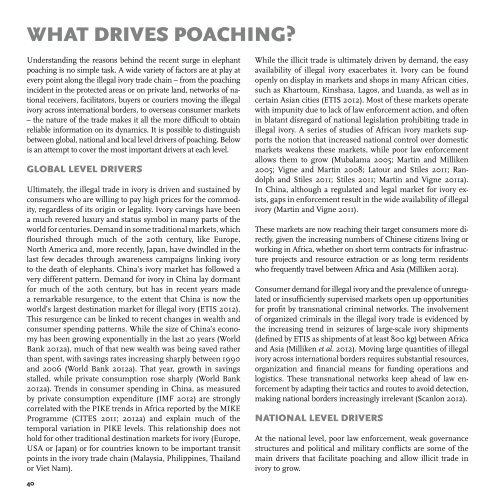'Elephants in the Dust' report - UNEP
'Elephants in the Dust' report - UNEP
'Elephants in the Dust' report - UNEP
You also want an ePaper? Increase the reach of your titles
YUMPU automatically turns print PDFs into web optimized ePapers that Google loves.
WHAT DRIVES POACHING?<br />
Understand<strong>in</strong>g <strong>the</strong> reasons beh<strong>in</strong>d <strong>the</strong> recent surge <strong>in</strong> elephant<br />
poach<strong>in</strong>g is no simple task. A wide variety of factors are at play at<br />
every po<strong>in</strong>t along <strong>the</strong> illegal ivory trade cha<strong>in</strong> – from <strong>the</strong> poach<strong>in</strong>g<br />
<strong>in</strong>cident <strong>in</strong> <strong>the</strong> protected areas or on private land, networks of national<br />
receivers, facilitators, buyers or couriers mov<strong>in</strong>g <strong>the</strong> illegal<br />
ivory across <strong>in</strong>ternational borders, to overseas consumer markets<br />
– <strong>the</strong> nature of <strong>the</strong> trade makes it all <strong>the</strong> more difficult to obta<strong>in</strong><br />
reliable <strong>in</strong>formation on its dynamics. It is possible to dist<strong>in</strong>guish<br />
between global, national and local level drivers of poach<strong>in</strong>g. Below<br />
is an attempt to cover <strong>the</strong> most important drivers at each level.<br />
Global level drivers<br />
Ultimately, <strong>the</strong> illegal trade <strong>in</strong> ivory is driven and susta<strong>in</strong>ed by<br />
consumers who are will<strong>in</strong>g to pay high prices for <strong>the</strong> commodity,<br />
regardless of its orig<strong>in</strong> or legal ity. Ivory carv<strong>in</strong>gs have been<br />
a much revered luxury and status symbol <strong>in</strong> many parts of <strong>the</strong><br />
world for centuries. Demand <strong>in</strong> some traditional markets, which<br />
flourished through much of <strong>the</strong> 20th century, like Europe,<br />
North America and, more recently, Japa n, have dw<strong>in</strong>dled <strong>in</strong> <strong>the</strong><br />
last few decades through awareness campaigns l<strong>in</strong>k<strong>in</strong>g ivory<br />
to <strong>the</strong> death of elephants. Ch<strong>in</strong>a’s ivory market has followed a<br />
very different pattern. Demand for ivory <strong>in</strong> C h<strong>in</strong>a lay dormant<br />
for much of <strong>the</strong> 20th century, but has <strong>in</strong> recent years made<br />
a remarkable resurgence, to <strong>the</strong> extent that Ch<strong>in</strong> a is now <strong>the</strong><br />
world’s largest dest<strong>in</strong>ation market for illegal ivory (ETIS 2012).<br />
This resurgence can be l<strong>in</strong>ked to recent changes <strong>in</strong> wealth and<br />
consumer spend<strong>in</strong>g patterns. While <strong>the</strong> size of C h<strong>in</strong>a’s economy<br />
has been grow<strong>in</strong>g exponentially <strong>in</strong> <strong>the</strong> last 20 years (World<br />
Bank 2012a), much of that new wealth was be<strong>in</strong>g saved ra<strong>the</strong>r<br />
than spent, with sav<strong>in</strong>gs rates <strong>in</strong>creas<strong>in</strong>g sharply between 1990<br />
and 2006 (World Bank 2012a). That year, growth <strong>in</strong> sav<strong>in</strong>gs<br />
stalled, while private consumption rose sharply (World Bank<br />
2012a). Trends <strong>in</strong> consumer spend<strong>in</strong>g <strong>in</strong> Ch<strong>in</strong>a, as measured<br />
by private consumption expenditure (IMF 2012) are strongly<br />
correlated with <strong>the</strong> PIKE trends <strong>in</strong> Africa <strong>report</strong>ed by <strong>the</strong> MIKE<br />
Programme (CITES 2011; 2012a) and expla<strong>in</strong> much of <strong>the</strong><br />
temporal variation <strong>in</strong> PIKE levels. This relationship does not<br />
hold for o<strong>the</strong>r traditional dest<strong>in</strong>ation markets for ivory (Europe,<br />
USA or Japan) or for countries known to be important transit<br />
po<strong>in</strong>ts <strong>in</strong> <strong>the</strong> ivory trade cha<strong>in</strong> (Malaysia, Philipp<strong>in</strong>es, Thailand<br />
or Viet Nam).<br />
While <strong>the</strong> illicit trade is ultimately driven by demand, <strong>the</strong> easy<br />
availability of illegal ivory exacerbates it. Ivory can be found<br />
openly on display <strong>in</strong> markets and shops <strong>in</strong> many African cities,<br />
such as Khartoum, K<strong>in</strong>shasa, Lagos, and Luanda, as well as <strong>in</strong><br />
certa<strong>in</strong> Asian cities (ETIS 2012). Most of <strong>the</strong>se markets operate<br />
with impunity due to lack of law enforcement action, and often<br />
<strong>in</strong> blatant disregard of national legislation prohibit<strong>in</strong>g trade <strong>in</strong><br />
illegal ivory. A series of studies of African ivory markets supports<br />
<strong>the</strong> notion that <strong>in</strong>creased national control over domestic<br />
markets weakens <strong>the</strong>se markets, while poor law enforcement<br />
allows <strong>the</strong>m to grow (Mubalama 2005; Mart<strong>in</strong> and Milliken<br />
2005; Vigne and Mart<strong>in</strong> 2008; Latour and Stiles 2011; Randolph<br />
and Stiles 2011; Stiles 2011; Mart<strong>in</strong> and Vigne 2011a).<br />
In Ch<strong>in</strong>a, although a regulated and legal market for ivory exists,<br />
gaps <strong>in</strong> enforcement result <strong>in</strong> <strong>the</strong> wide availability of illegal<br />
ivory (Mart<strong>in</strong> and Vigne 2011).<br />
These markets are now reach<strong>in</strong>g <strong>the</strong>ir target consumers more directly,<br />
given <strong>the</strong> <strong>in</strong>creas<strong>in</strong>g numbers of Ch<strong>in</strong>ese citizens liv<strong>in</strong>g or<br />
work<strong>in</strong>g <strong>in</strong> Africa, whe<strong>the</strong>r on short term contracts for <strong>in</strong>frastructure<br />
projects and resource extraction or as long term residents<br />
who frequently travel between Africa and Asia (Milliken 2012).<br />
Consumer demand for illegal ivory and <strong>the</strong> prevalence of unregulated<br />
or <strong>in</strong>sufficiently supervised markets open up opportunities<br />
for profit by transnational crim<strong>in</strong>al networks. The <strong>in</strong>volvement<br />
of organized crim<strong>in</strong>als <strong>in</strong> <strong>the</strong> illegal ivory trade is evidenced by<br />
<strong>the</strong> <strong>in</strong>creas<strong>in</strong>g trend <strong>in</strong> seizures of large-scale ivory shipments<br />
(def<strong>in</strong>ed by ETIS as shipments of at least 800 kg) between Africa<br />
and Asia (Milliken et al. 2012). Mov<strong>in</strong>g large quantities of illegal<br />
ivory across <strong>in</strong>ternational borders requires substantial resources,<br />
organization and f<strong>in</strong>ancial means for fund<strong>in</strong>g operations and<br />
logistics. These transnational networks keep ahead of law enforcement<br />
by adapt<strong>in</strong>g <strong>the</strong>ir tactics and routes to avoid detection,<br />
mak<strong>in</strong>g national borders <strong>in</strong>creas<strong>in</strong>gly irrelevant (Scanlon 2012).<br />
National level drivers<br />
At <strong>the</strong> national level, poor law enforcement, weak governance<br />
structures and political and military conflicts are some of <strong>the</strong><br />
ma<strong>in</strong> drivers that facilitate poach<strong>in</strong>g and allow illicit trade <strong>in</strong><br />
ivory to grow.<br />
40
















